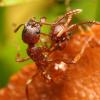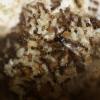So I currently three Queens, one that is housed in a formicarium and two that still is in testtubes.
Now the testtubes queens only have eggs and larvae and since I used pretty short tettube I have the problem with future watersupply.
So my question is, should I take the "late" queens brood and give it to the queen in the formicarium thus dooming them to be alone or should I move them to other testtubes?
(I have a feeling that they will hibernate with the brood since they should be hibernating pretty soon, right?
















